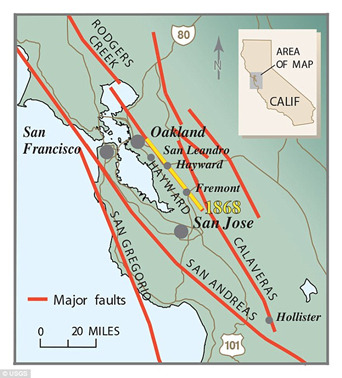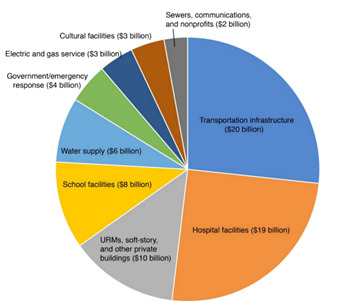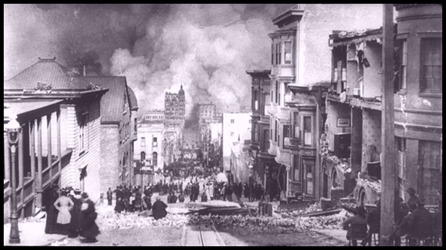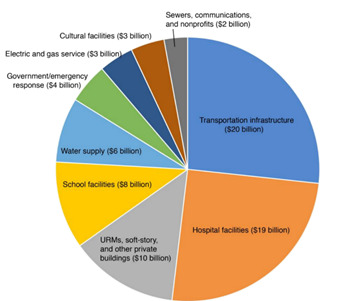Don't wanna be here? Send us removal request.
Text
Earthquake Management in the Bay Area
Earthquakes occur all over the world. These hazards can cause incredible damages, from death and injury to destruction of buildings and infrastructure. Because of this danger, it is imperative that areas plan for how to prepare for and manage earthquakes when they do happen. An area of interest regarding earthquakes is the Bay Area in California, as this area has experienced a number of high magnitude and high damage earthquakes. This idea led me to wonder, How have past earthquakes in the Bay Area influenced current policies and management practices? I set out to answer this question. To do so, I will look at the past, present and future of Earthquakes in the Bay Area.
In 2003, the United States Geological Survey reported that in the next 30 years, there is a probability of 62% that a 6.7 or greater magnitude earthquake will occur in the Bay Area(3). This is quite a concerning estimation considering that the Bay Area contains San Francisco, several other cities, and millions of people.
The population of the Bay Area has grown significantly over time, and now inhabits around 7 million people(3). While everyone living in the Bay Area is at risk, there are some areas in greater danger than others. Areas that contain the greatest risk of earthquakes are those surrounding the San Andreas fault and the Hayward-Rogers Greek Fault system(3). These fault lines can be seen in the image below.

Effects of the Past and Lessons for the Future
To effectively study the management of earthquakes in the Bay Area, it’s important to look at destructive earthquakes of the past and how these have informed management practices of the present. One of the most notable earthquakes to ever happen occurred on April 18th of 1906. This earthquake, which occurred along 296 miles of the San Andreas fault, is significant because of the information that has been gathered from studying it(5). In fact, this earthquake led to the creation of the elastic-rebound theory, which today remains the principal model of the earthquake cycle(5). The 1906 earthquake was a long and devastating one, causing 700 deaths and a fire in San Francisco (700 was the reported number of deaths, but it is estimated that the real death toll was much higher). It was felt all the way from Los Angeles to Oregon, and even Nevada(5). The photo below offers a glimpse into the aftermath of this hazardous event.

Another major Bay Area earthquake that affected how earthquakes are managed today was the Loma Prieta earthquake of 1989. While this earthquake caused significantly fewer deaths than the earthquake of 1906, it resulted in around 6 billion dollars in damages(4). This earthquake also resulted in a report published in the National Academies Press by George Mader, which discussed how this earthquake should inform future management practices in the Bay Area(4). While this report focuses on the issue of funding regarding earthquakes, Mader also formulated lessons to be learned regarding the rebuilding and mitigation processes of earthquakes, along with several other areas. His lessons in mitigation are particularly significant, and include the following:
1. Buildings prone to hazards should be updated to withstand earthquakes or removed entirely
2. Old houses should be secured to foundations
3. Land planning and zoning should be conducted to avoid areas prone to hazards
4. Rigorous requirements should be implemented for building permits(4)
Present Day Efforts
Today, the Bay Area is much more adequately prepared to handle major earthquakes than they were in decades past. Since the Loma Prieta earthquake, around $80 billion has been invested into earthquake mitigation in the Bay Area, and much of this has come from public funding(1). These investments have been made in all areas, including water supply systems, communication infrastructure, government buildings, and emergency response systems. The full breakdown of these investments is shown below:

(1)
Previously discussed earthquakes in the Bay Area have caused bridges and buildings to be severely damaged or collapsed, and the risk of this hazard remains very high. Thankfully, a plethora of structural changes, removals, and replacements have been implemented to help with earthquake mitigation and resiliency of the Bay Area.
The Bay Area Earthquake Plan, created in 2016, outlines exactly what the Bay Area will do when an earthquake inevitably occurs(2). This plan includes every detail of earthquake management, from emergency communication procedures to exactly how rebuilding will take place. With a mission to “save and sustain human lives, minimize suffering, stabilize and restore critical infrastructure, and facilitate recovery following a severe earthquake in the Bay Area”, residents of the Bay Area should feel confident that they will be taken care of in the event of another major hazard(2).
The Future: When Another Earthquake Hits
The 1906 Bay Area earthquake was over 100 years ago, but disaster is bound to strike again. It’s almost strange that a similar earthquake has not yet occurred. Therefore, how can the Bay Area manage, prepare for, and mitigate an invisible but approaching hazard? With developing technologies, we can do our best to prepare for the worst by studying, modeling, and projecting future disasters. This is especially important due to the constantly increasing population of the Bay Area(6).
If another major earthquake occurs, it is likely that the disaster would result in loss of electrical power and phone communications, thousands of deaths, and inaccessibility to water for many(6). Not to mention, there could be monetary damages in the hundreds of billions. The greatest issue in planning for earthquakes is consideration of the aftermath – after all, there are limits to the amount of emergency responders available, and there is almost no limit to the depth of possible damage(6).
While the idea of major earthquakes in the Bay Area is daunting, the management of such hazards is imperative. All layers of government, from state to local, need coordinated plans for preparedness, mitigation and rehabilitation. Thankfully, with implementation of the previously discussed Bay Area Earthquake Plan, citizens and government entities have outlined procedures in the event of another major earthquake. Laws and expert recommendations should be followed to specific detail, and practicing should be commonplace. There is much to be learned from the past, and much to be prepared for the future.
References:
1. Brocher, T., Gefeke, K., Boatwright, J., & Knudsen, K. (2018). Reported investments in earthquake mitigation top $73 to $80 billion in the San Francisco Bay Area, California, since the 1989 Loma Prieta earthquake. Reston, VA: U.S. Geological Survey. Retrieved from https://pubs.er.usgs.gov/publication/ofr20181168
2. California Governor's Office of Emergency Services. (2016). Bay Area Earthquake Plan [Ebook]. Retrieved from https://www.caloes.ca.gov/PlanningPreparednessSite/Documents/BayAreaEQConops(Pub_Version)_2016.pdf
3. Earthquake Hazards of The Bay Area Today. Retrieved 9 October 2019, from https://earthquake.usgs.gov/earthquakes/events/1906calif/virtualtour/modern.php
4. Mader, G. (1994). Practical Lessons from the Loma Prieta Earthquake [Ebook] (pp. 219-238). The National Academies Press. Retrieved from https://www.nap.edu/read/2269/chapter/9
5. The Great 1906 San Francisco Earthquake. (2019). Retrieved 9 October 2019, from https://earthquake.usgs.gov/earthquakes/events/1906calif/18april/
6. Veklerov, K. (2019). What a major earthquake would do to San Francisco. Retrieved 9 October 2019, from https://www.sfchronicle.com/bayarea/article/What-a-major-earthquake-would-do-to-San-Francisco-13764363.php
0 notes
Text
Earthquake Management in the Bay Area
Earthquakes occur all over the world. These hazards can cause incredible damages, from death and injury to destruction of buildings and infrastructure. Because of this danger, it is imperative that areas plan for how to prepare for and manage earthquakes when they do happen. An area of interest regarding earthquakes is the Bay Area in California, as this area has experienced a number of high magnitude and high damage earthquakes. So, how are earthquakes managed in the Bay Area? I set out to answer this question. To do so, I will look at the past, present and future of Earthquakes in the Bay Area.
In 2003, the United States Geological Survey reported that in the next 30 years, there is a probability of 62% that a 6.7 or greater magnitude earthquake will occur in the Bay Area(3). This is quite a concerning estimation considering that the Bay Area contains San Francisco, several other cities, and millions of people.
The population of the Bay Area has grown significantly over time, and now inhabits around 7 million people(3). While everyone living in the Bay Area at risk, there are some areas in greater danger than others. Areas that contain the greatest risk of earthquakes are those surrounding the San Andreas fault and the Hayward-Rogers Greek Fault system(3).
Effects of the Past and Lessons for the Future
To effectively study the management of earthquakes in the Bay Area, it’s important to look at destructive earthquakes of the past and how these have informed management practices of the present. One of the most notable earthquakes to ever happen occurred on April 18th of 1906. This earthquake, which occurred along 296 miles of the San Andreas fault, is significant because of the information that has been gathered from studying it(5). In fact, this earthquake led to the creation of the elastic-rebound theory, which today remains the principal model of the earthquake cycle(5). The 1906 earthquake was a long and devastating one, causing 700 deaths and a fire in San Francisco. It was felt all the way from Los Angeles to Oregon, and even Nevada(5).

Another major Bay Area earthquake that affected how earthquakes are managed today was the Loma Prieta earthquake of 1989. While this earthquake caused significantly fewer deaths than the earthquake of 1906, it resulted in around 6 billion dollars in damages(4). This earthquake also resulted in a report published in the National Academies Press by Geoge Mader, which discussed how this earthquake should inform future management practices in the Bay Area(4). While this report focuses on the issue of funding regarding earthquakes, Mader also formulated lessons to be learned regarding the rebuilding and mitigation processes of earthquakes, along with several other areas. His lessons in mitigation are particularly significant, and include the following:
1. Buildings prone to hazards should be updated to withstand earthquakes or removed entirely
2. Old houses should be secured to foundations
3. Land planning and zoning should be conducted to avoid areas prone to hazards
4. Rigorous requirements should be implemented for building permits(4)
Present Day Efforts
Today, the Bay Area is much more adequately prepared to handle major earthquakes than they were in decades past. Since the Loma Prieta earthquake, around $80 billion has been invested into earthquake mitigation in the Bay Area, and much of this has come from public funding(1). These investments have been made in all areas, including water supply systems, communication infrastructure, government buildings, and emergency response systems. The full breakdown of these investments is shown below:

(1)
Previously discussed earthquakes in the Bay Area have caused bridges and buildings to be severely damaged or collapsed, and the risk of this hazard remains very high. Thankfully, a plethora of structural changes, removals, and replacements have been implemented to help with earthquake mitigation and resiliency of the Bay Area(1).
The Bay Area Earthquake Plan, created in 2016, outlines exactly what the Bay Area will do when an earthquake inevitably occurs(2). This plan includes every detail of earthquake management, from emergency communication procedures to exactly how rebuilding will take place. With a mission to “save and sustain human lives, minimize suffering, stabilize and restore critical infrastructure, and facilitate recovery following a severe earthquake in the Bay Area”, residents of the Bay Area should feel confident that they will be taken care of in the event of another major hazard(2).
The Future: When Another Earthquake Hits
The 1906 Bay Area earthquake was over 100 years ago, but disaster is bound to strike again. It’s almost strange that a similar earthquake has not yet occurred. Therefore, how can the Bay Area manage, prepare for, and mitigate an invisible but approaching hazard? With developing technologies, we can do our best to prepare for the worst by studying, modeling, and projecting future disasters. This is especially important due to the constantly increasing population of the Bay Area(6).
If another major earthquake occurs, it is likely that the disaster would result in loss of electrical power and phone communications, thousands of deaths, and inaccessibility to water for many(6). Not to mention, there could be monetary damages in the hundreds of billions. The greatest issue in planning for earthquakes is consideration of the aftermath – after all, there are limits to the amount of emergency responders available, and there is almost no limit to the depth of possible damage(6).
While the idea of major earthquakes in the Bay Area is daunting, the management of such hazards is imperative. All layers of government, from state to local, need coordinated plans for preparedness, mitigation and rehabilitation. Laws and expert recommendations should be followed to specific detail, and practicing should be commonplace. There is much to be learned from the past, and much to be prepared for the future.
References:
1. Brocher, T., Gefeke, K., Boatwright, J., & Knudsen, K. (2018). Reported investments in earthquake mitigation top $73 to $80 billion in the San Francisco Bay Area, California, since the 1989 Loma Prieta earthquake. Reston, VA: U.S. Geological Survey. Retrieved from https://pubs.er.usgs.gov/publication/ofr20181168
2. California Governor's Office of Emergency Services. (2016). Bay Area Earthquake Plan [Ebook]. Retrieved from https://www.caloes.ca.gov/PlanningPreparednessSite/Documents/BayAreaEQConops(Pub_Version)_2016.pdf
3. Earthquake Hazards of The Bay Area Today. Retrieved 9 October 2019, from https://earthquake.usgs.gov/earthquakes/events/1906calif/virtualtour/modern.php
4. Mader, G. (1994). Practical Lessons from the Loma Prieta Earthquake [Ebook] (pp. 219-238). The National Academies Press. Retrieved from https://www.nap.edu/read/2269/chapter/9
5. The Great 1906 San Francisco Earthquake. (2019). Retrieved 9 October 2019, from https://earthquake.usgs.gov/earthquakes/events/1906calif/18april/
6. Veklerov, K. (2019). What a major earthquake would do to San Francisco. Retrieved 9 October 2019, from https://www.sfchronicle.com/bayarea/article/What-a-major-earthquake-would-do-to-San-Francisco-13764363.php
[i] Brocher, T., Gefeke, K., Boatwright, J., & Knudsen, K. (2018). Reported investments in earthquake mitigation top $73 to $80 billion in the San Francisco Bay Area, California, since the 1989 Loma Prieta earthquake. Reston, VA: U.S. Geological Survey. Retrieved from https://pubs.er.usgs.gov/publication/ofr20181168
1 note
·
View note